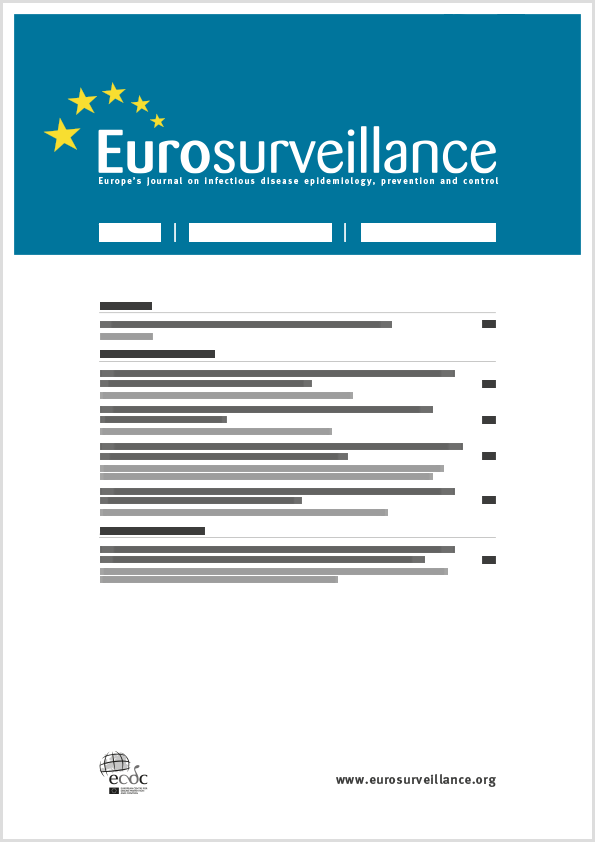- Home
- Eurosurveillance
- Previous Issues
- Volume 28, Issue 44, 02/Nov/2023
Eurosurveillance - Volume 28, Issue 44, 02 November 2023
Volume 28, Issue 44, 2023
- Rapid communication
-
-
-
Outbreaks of autochthonous Dengue in Lazio region, Italy, August to September 2023: preliminary investigation
Gabriella De Carli , Fabrizio Carletti , Martina Spaziante , Cesare Ernesto Maria Gruber , Martina Rueca , Pietro Giorgio Spezia , Valentina Vantaggio , Alessandra Barca , Claudio De Liberato , Federico Romiti , Maria Teresa Scicluna , Stefania Vaglio , Mariano Feccia , Enrico Di Rosa , Francesco Paolo Gianzi , Cristina Giambi , Paola Scognamiglio , Emanuele Nicastri , Enrico Girardi , Fabrizio Maggi , Francesco Vairo and the Lazio Dengue Outbreak GroupMore LessBetween August and September 2023, three distinct autochthonous dengue virus transmission events occurred in Lazio, Italy, with the main event in Rome. The events involved three different dengue serotypes. No link with previous imported cases was identified. Here we describe the epidemiological and phylogenetic analysis of the first autochthonous cases and the implemented control actions. The multiple transmission events call for a strengthening of the vector control strategies and future research to better characterise the risk in countries like Italy.
-
- Top
-
- Outbreaks
-
-
-
Outbreak of Corynebacterium diphtheriae among asylum seekers in Belgium in 2022: operational challenges and lessons learnt
More LessSince 2022, European countries have been facing an outbreak of mainly cutaneous diphtheria caused by toxigenic Corynebacterium diphtheriae among asylum seekers. In Belgium, between 1 March and 31 December 2022, 25 cases of toxigenic C. diphtheriae infection were confirmed among asylum seekers, mostly among young males from Afghanistan. Multi-locus sequence typing showed that most isolates belonged to sequence types 574 or 377, similar to the majority of cases in other European countries. The investigation and management of the outbreak, with many asylum seekers without shelter, required adjustments to case finding, contact tracing and treatment procedures. A test-and-treat centre was organised by non-governmental organisations, the duration of the antimicrobial treatment was shortened to increase compliance, and isolation and contact tracing of cases was not possible. A vaccination centre was opened, and mobile vaccination campaigns were organised to vaccinate a maximum of asylum seekers. No more cases were detected between end December 2022 and May 2023. Unfortunately, though, three cases of respiratory diphtheria, including one death, were reported at the end of June 2023. To prevent future outbreaks, specific attention and sufficient resources should be allocated to this vulnerable population, in Belgium and at international level.
-
- Top
-
- Research
-
-
-
PCR testing of traced contacts for SARS-CoV-2 in England, January to July 2021
More LessBackgroundThe NHS Test and Trace (NHSTT) programme was established in May 2020 in England to deliver SARS-CoV-2 testing and contact tracing in order to identify infected individuals and reduce COVID-19 spread. To further control transmission, people identified as contacts were asked to self-isolate for 10 days and test only if they became symptomatic. From March 2021, eligibility criteria for PCR testing expanded to include asymptomatic contacts of confirmed cases.
AimTo analyse testing patterns of contacts before and after the change in testing guidance in England to assess the impact on PCR testing behaviour with respect to symptom status and contact type.
MethodsTesting and contact tracing data were extracted from the national data systems and linked. Subsequently, descriptive statistical analysis was applied to identify trends in testing behaviour.
ResultsBetween 1 January and 31 July 2021, over 5 million contacts were identified and reached by contact tracers; 42.3% took a PCR test around the time they were traced. Overall positivity rate was 44.3% and consistently higher in symptomatic (60–70%) than asymptomatic (around 20%, March–June) contacts. The proportion of tests taken by asymptomatic contacts increased over time, especially after the change in testing guidance. No link was observed between uptake of PCR tests and vaccination coverage. Fully vaccinated contacts showed lower positivity (23.8%) than those with one dose (37.2%) or unvaccinated (51.0%).
ConclusionAlmost 1 million asymptomatic contacts were tested for SARS-CoV-2, identifying 214,056 positive cases, demonstrating the value of offering PCR testing to this group.
-
-
Volumes & issues
-
Volume 29 (2024)
-
Volume 28 (2023)
-
Volume 27 (2022)
-
Volume 26 (2021)
-
Volume 25 (2020)
-
Volume 24 (2019)
-
Volume 23 (2018)
-
Volume 22 (2017)
-
Volume 21 (2016)
-
Volume 20 (2015)
-
Volume 19 (2014)
-
Volume 18 (2013)
-
Volume 17 (2012)
-
Volume 16 (2011)
-
Volume 15 (2010)
-
Volume 14 (2009)
-
Volume 13 (2008)
-
Volume 12 (2007)
-
Volume 11 (2006)
-
Volume 10 (2005)
-
Volume 9 (2004)
-
Volume 8 (2003)
-
Volume 7 (2002)
-
Volume 6 (2001)
-
Volume 5 (2000)
-
Volume 4 (1999)
-
Volume 3 (1998)
-
Volume 2 (1997)
-
Volume 1 (1996)
-
Volume 0 (1995)
Most Read This Month

-
-
Detection of 2019 novel coronavirus (2019-nCoV) by real-time RT-PCR
Victor M Corman , Olfert Landt , Marco Kaiser , Richard Molenkamp , Adam Meijer , Daniel KW Chu , Tobias Bleicker , Sebastian Brünink , Julia Schneider , Marie Luisa Schmidt , Daphne GJC Mulders , Bart L Haagmans , Bas van der Veer , Sharon van den Brink , Lisa Wijsman , Gabriel Goderski , Jean-Louis Romette , Joanna Ellis , Maria Zambon , Malik Peiris , Herman Goossens , Chantal Reusken , Marion PG Koopmans and Christian Drosten
-
- More Less


